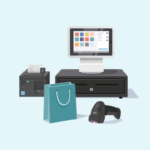Here’s the bottom line. Email marketing is a practical, effective, and affordable strategy to help today’s retailers strengthen customer relationships and drive sales.
Email marketing is practical because it’s relatively easy to implement. By collecting a customer’s email address, you’re able to continue the conversation after they leave your store or e-commerce site. Email marketing tools like Mailchimp that integrate with your point of sale (POS) system help you automate your efforts and stay compliant with email regulations.
Email marketing is effective because it puts timely, relevant messages in front of your customers on a regular basis. These messages keep your store top of mind by sharing product updates, promotions, and expert advice. And, 72 percent of consumers prefer to receive promotional messages via email.
And finally, email marketing is affordable. For every dollar spent creating and sending an email, retailers see an impressive average return on investment of $42.
For retailers, implementing an email marketing strategy that generates sales starts with five basic elements.
1. Become a collector.
In order to build a successful email strategy, you have to collect your customers’– and prospective customers’ – email addresses. Don’t hesitate to ask. Customers are accustomed to sharing their email address in exchange for a positive shopping experience or access to your store’s rewards program.
First, deliver in-store and e-commerce experiences customized for your target customers. Then, seamlessly ask for an email address as part of the checkout process. Make sure your POS has robust customer relationship capabilities, including the ability to capture profile details like email addresses, birthdates, and style preferences. Mobile POS capabilities are also an effective way to authentically collect customer information as you serve them in-store.
Related: Does Your POS System Have the Right Answers to These 3 Questions?
2. Pull the trigger.
One-size-fits-all email blasts are out. Build your email marketing strategy around messages triggered based on customer actions and behaviors. Welcome and thank new customers. Recognize achievements, such as when a customer qualifies for Platinum status in your rewards program. Suggest a complementary product based on an item the customer recently purchased.
Email platforms like Mailchimp make automating trigger campaigns simple, especially when you’re able to integrate your POS data.
3. Get personalized.
Personalization counts. Sixty-three percent of consumers expect personalized marketing messages from retailers that recognize them as individuals – but many feel like retailers aren’t keeping up with their expectations. One-third of shoppers express frustration when retailers send them offers that aren’t relevant for their situation, promote an item they recently purchased, or fail to recognize they’re already existing customers.
Your POS should capture customer profile and purchase details. Email makes turning the data points into personalized marketing campaigns do-able. Emails with personalized subject lines generate 50 percent higher open rates and are six times more likely to prompt the reader to take action. When you combine personalized messages with the trigger-based campaigns described above, your store’s marketing campaigns will stand out. According to the Data and Marketing Association, only 39 percent of retailers are currently sending personalized recommendations via email.
Related: How Smart Retailers Build Ideal Customer Profiles that Drive Sales

4. Show your personality.
We all get a lot of emails. In 2020 alone, an estimated 306.4 billion emails will be sent and received. While your customers are receptive to email messages from their favorite retail brands, bland subject lines and ordinary messages will get lost in the shuffle.
Along with personalization, focus on showing your brand’s unique personality in your messages. Catch customer’s attention with fun subject lines that make them curious. Then, pay it off with relevant information they value. Your content doesn’t always have to be discount-oriented to be valuable. Mix in product information, invitations to exclusive preview events, and expert tips. Once you’ve proven that your emails are worthwhile (and a little fun!), your customers will look for them in their inbox.
5. Ask for action.
Don’t send out dead-end emails. Whether it’s a thank you message or an upsell campaign, always give your customers a next step. Invite them to download a coupon or register for an event. Offer a click-through to your e-commerce site to browse suggested items or shop online. Give them a link to set up a personal shopping appointment in-store. If you want your message to drive results, a strong call-to-action is essential. Email marketing can be a winner when it comes to expanding customer relationships and generating sales. For more on how you can effectively leverage your POS data to optimize your marketing and operational strategies, download our new guide, Data-driven Decisions: The Definitive Guide for Retailers. And contact us for a demo to discover how POSIM can help.











